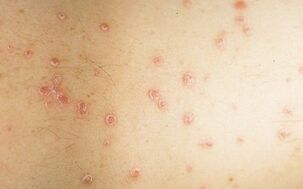According to official figures, about 3% of people worldwide suffer from psoriasis. But it should be assumed that the actual number of patients with this type of dermatosis is much larger. Basically, the first signs of the disease occur at the age of 10-25 years, although cases of psoriasis diagnosis have been recorded in infants and the elderly. It is not yet known for sure why it developed, but doctors have information on how early stages of psoriasis are. Therefore, with timely access to a specialist, you can stop the progression of the disease at an early stage.
Early stage symptoms
Initially, small round papules begin to appear on the patient's skin, the size of which, as a rule, does not exceed the diameter of the shoot. The formation has a smooth, shiny surface and clear contours, but literally after a few days they begin to peel off. The scales produced are silvery white and easily removed from the papule surface. Over time, the number and size of rash elements increase, and the disease progresses to a progressive stage.
A large number of papules are reddish or pink, although in some cases they turn bluish. This is observed with the formation of the main elements of the rash on the feet. Depending on the type of disease, the early stages of psoriasis manifest on the elbows (extensor surface), knees, body, limbs or scalp.
If you remove all the scales from the acne, you will find a really smooth glossy surface underneath - the terminal film. But by scraping further, it quickly breaks down, and the smallest droplets of blood begin to appear.
Thus, psoriasis is characterized by three specific phenomena:

- stearin spot- increased exfoliation when removing scales;
- psoriatic film- exfoliation of the thinnest layers of skin;
- blood dew- the appearance of blood droplets right after scraping.
But it is easier to see what the initial stage of psoriasis is in the photo.
Despite advances in medicine, today there is no cure that can completely cure psoriasis. The disease is characterized by a non-corrosive pathway, therefore, not only those who first suffer from a similar disease, but also those who have lived with it for many years past the early stages of its development.
I would like to emphasize that there is no cure for psoriasis. With the help of modern medicine, physiotherapy procedures and other methods of therapy, you can "push" the disease to a stable state of remission and, perhaps, forget about it for several years. But this does not mean that in the combination of unfavorable conditions, the patient will again not notice the characteristic rash that indicates the early stages of psoriasis on the hands and other parts of the body.
How do you know if psoriasis is getting worse?
The transition of psoriasis to the second or progressive stage is evidenced by the growth and melting of the previous single papule, as well as the addition of pre-existing itching. In addition, the nature of peeling also changes. Now it is observed only in the middle of the formation, and its edges remain free of scales. This clearly indicates the growth of the element.
To confirm the transition of psoriasis to the second stage, you can use this type of test. The essence consists of minor damage to the skin in the affected area. If, after about a week, a psoriatic element of the same form with the injury is formed in the same place, this clearly indicates the development of the disease. In the specialized literature, such tests are described as Kebner symptoms. Moreover, this can be seen even by brushing the superficial exposed skin.
In some cases, patients have exudative psoriasis. It is characterized by the release of special fluids. The scales are impregnated with it, as a result of which they turn into a dense crust. If one of these crusts is removed or damaged, the area of skin that comes out will be exposed.























